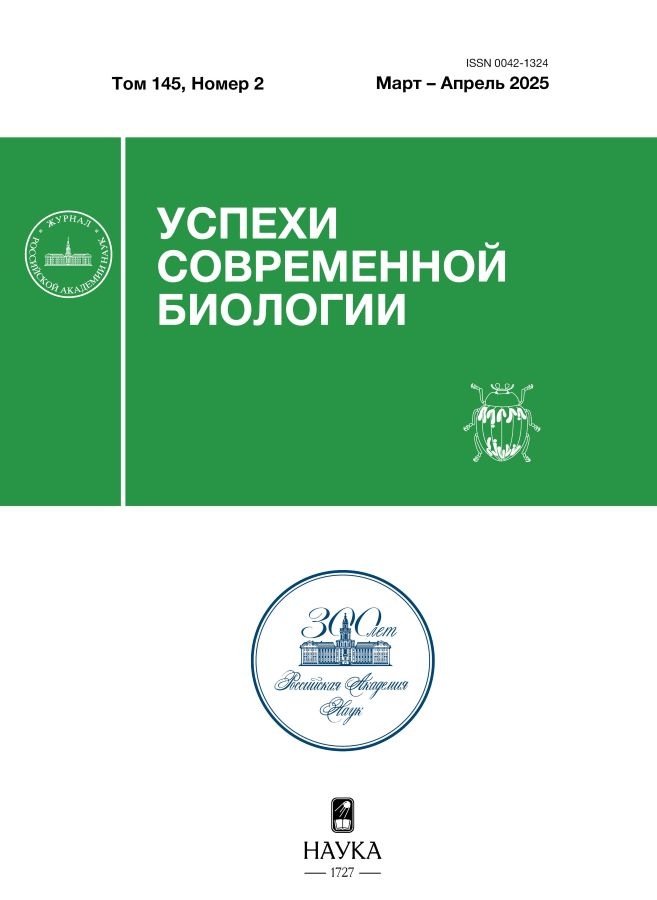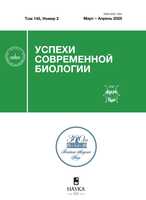Uspehi sovremennoj biologii
Media registration certificate: ПИ № ФС 77 - 66717 от 28.07.2016
The journal is a source of up-to-date and comprehensive information on the state and achievements of current biology, and covers a variety of biological disciplines including
biogeography, botany, zoology, paleontology, embryology, taxonomy, evolutionary theory, physiology, and ecology. The journal also considers all aspects of adaptive mechanisms
and strategies, problems of genetics and molecular biology, current taxonomy, ethology, and biomedical problems. The focus of the journal is general biological problems related
to the organization and development of different life forms on the Earth. Although the journal is broad-scoped, it encourages publications dealing with biological macroobjects
(organisms, populations, and communities), since these studies form the basis of general biological theories and concepts.
Current Issue
Vol 145, No 2 (2025)
- Year: 2025
- Published: 10.07.2025
- Articles: 11
- URL: https://cardiosomatics.orscience.ru/0042-1324/issue/view/13647
Full Issue
Articles
Monoclonal antibodies to a variable fragment of the T cell receptor – at the service of science and medicine
Abstract
This review summarizes recent progress in the engineering of monoclonal antibodies directed to a variable fragment of the T cell receptor with a given mode of action on the targeted subset of T lymphocytes. Since the unique T cell subsets are responsible for the development and outcome of many socially significant diseases the ability of monoclonal antibodies to deplete or expand pathogenetically important T cell families is of a grate interest in clinical practice. The review also discusses the role of the unique T cell families in the pathogenesis of a number of autoimmune and infectious diseases, which provides the prerequisites for the creation of highly effective targeted drugs based on monoclonal antibodies to a variable fragment of the T cell receptor.
 93-115
93-115


Evaluation of gut microbial diversity of the domestic goat Capra hircus
Abstract
Domestic goats remain important as farm animals, whose health influences the quality and yield of livestock products. Animal health depends on housing conditions and nutrition, including effective digestion, which is significantly influenced by microorganisms inhabiting the pathways of the gastrointestinal tract. Ruminants, such as goats, host a unique community of bacteria, that varies depending on age and region of residence. One major challenge is identifying the normal members of the goat gut microbiome, and distinguishing these from members that may vary in goats without indicating disease. This study synthesizes available published data to address this issue.
 116-122
116-122


Domestic goat as a promising animal model for high-level brain function research
Abstract
Goats were the first animals to undergo domestication. Despite the fact that they are bred across much of the world, they have not yet been widely used as a research model. However, goats have remarkable cognitive abilities, complex and varied social behaviour, and due to their size and low maintenance requirements, they may serve as a promising model for studying neurological conditions, especially neurodegenerative diseases. This review focuses on current research into the central nervous system of goats, as well as their behaviour and cognitive abilities.
 123-130
123-130


The quality of activity and its importance in the evolution of vertebrates
Abstract
The article describes a new characteristic that is important in the process of evolution of vertebrates – the quality of activity. This is a set of properties that primarily describes the motor activity of animals, and manifests itself in the energy supply of activity and work of the nervous system (and at all levels – from oxidation in the mitochondria to the basic metabolism of the whole organism), in speed, coordination and accuracy of movements, in optimizing purposeful, expedient behavior due to the activity of the central nervous system, in endurance and other properties that give animals selective advantages in competition with other animal groups, create prerequisites for their ecological and evolutionary success. This characteristic is important primarily for vertebrates. Improving the quality of activity is the most important direction in the evolution of vertebrates. It indirectly includes the evolutionary characteristics of a multitude of internally interconnected functional systems of the body (musculoskeletal system, energy system from molecular to ecological levels, circulatory and respiratory systems, central nervous system, behavior, etc.), and is thus an integral characteristic responsible for the interrelation of the vital activity of the body with the external environment, its adaptations, for its interaction with cenoses of different levels. In our opinion, the quality of activity is a key characteristic, which ultimately is the “axis” around which the evolution of the complex of vertebrates is formed, and which is the basis, the direction of natural selection in this group of animals, ensuring the improvement of all other functionally interconnected internal systems of the body. This crucial characteristic requires further study and development.
 131-136
131-136


The current concepts of fish systematics
Abstract
The war between the crushing taxonomists and the combining taxonomists has been waged since the time of Linnaeus. In recent years, the mass fascination with taxonomy has become a fashionable trend. Geneticists, biochemists, and molecular scientists are now engaged in taxonomy, which introduces different interpretations at the levels of both micro- and macro-mathematics. This is due to the fact that everyone comes to taxonomy with their own subjective concepts of the species, genus and family. This gives rise to many different taxonomic systems and even the opinion that taxonomy ceases to be a science and becomes a subjective point of view. Measures are proposed to eliminate this phenomenon.
 137-152
137-152


Advances in applied genomics of white poplars: results and prospects of genome editing and modification
Abstract
Genome editing has many potential applications in green building and forestry by altering genome sequences that control tree growth and development, stress response, and resistance to diseases and pests. Using tools such as CRISPR/Cas9 targeted changes in genomes can improve desired quantitative and qualitative traits. Genome editing has great potential to solve problems in silviculture: by manipulating genes associated with lignin biosynthesis, researchers have successfully reduced the lignin content of poplar wood, increasing the efficiency of fiber production; genome editing applied to increase cellulose production has resulted in increased biomass productivity; various genome editing techniques have been used to control poplar blooms, allowing sterile forms to be bred, preventing the spread of genetically modified traits among non-target populations.
 153-160
153-160


Preface by the Editor-in-Chief
 161-161
161-161


DISCUSSIONS
Book review: Andrei P. Kozlov “Evolution by tumor neofunctionalization: the role of tumors in the origin of new cell types, tissues and organs”. Amsterdam, Boston, Heidelberg, London, New York, Oxford, Paris, San Diego, San Francisco, Singapore, Sydney, Tokyo: Academic Press/Elsevier, 2014. 248 p. ISBN: 978-0-12-800165-3
Abstract
A review of the book by Professor Andrei P. Kozlov is presented. It is noted that the neofunctionalization of tumors is definitely an unconventional idea put forward by a decidedly unconventional thinker. The book combines both well-known evolutionary and ecological concepts, as well as little-known theories, and thoughtful consideration is given to each of them. And although many scientists will undoubtedly disagree with its main conclusions (it remains to be seen whether examples such as the goldfish cap are the exception or the rule), the book in many ways encourages reflection and provides ample ground for experimentation, thereby stimulating the further development of scientific thought. “Evolution by neofunctionalization of tumors” by A.P. Kozlov will be an important reading for anyone studying evolution and genomics, especially for the ideological leaders of Darwinian medicine.
 162-165
162-165


Review of the series of articles “A theory of the evolutionary role of hereditary tumors (carcino-evo-devo): the history and the current state” in four parts, published in the journal “Advances in current biology” in 2024
Abstract
E.D. Sverdlov, Doctor of Chemical Sciences, Academician of the Russian Academy of Sciences, provided a review of a series of articles, published in the journal “Advances in Current Biology” in 2024. The reviewer believes, that the presented 4 parts of the article “Theory of the evolutionary role of inherited tumors (carcino-evo-devo): history of development and current state” (Kozlov, 2024) summarize the enormous work of Andrei P. Kozlov, and his colleagues on proving the concept of the role of hereditary tumors in evolution put forward by A.P. Kozlov. This theory, called by the author the theory of carcino-evo-devo, may become a unifying biological theory.
 166-168
166-168


On the theory of increasing complexity by professor A.P. Kozlov, published in a series of papers in 2024
Abstract
A series of works by Professor A.P. Kozlov, published in the journals “Advances in Current Biology” and “Paleontological Journal” in 2024, is devoted to fundamental issues of the evolutionary development of living organisms, the analysis of which is based on the role of inherited tumors as a natural mechanism for the formation of evolutionarily new tissues and organs. The study of this mechanism is the basis for the theory of carcino-evo-devo, which, according to the author, explains the process of increasing the biological complexity of living organisms. In this review the conclusions from the new chapters of A.P. Kozlov’s theory concerning the increasing complexity of living organisms from the standpoint of computer science and information technology are analyzed.
 169-172
169-172


Echo of carcino-evo-devo. On the beneficial role of inherited tumors in the evolution of organisms
Abstract
The analytical article critically examines some aspects of the theory of carcino-evo-devo, testing its strength, which is known to be useful for strengthening and improving both new and long-established ideas in the scientific world.
 173-190
173-190












